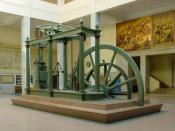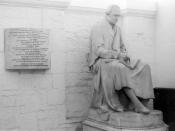James WattJames Watt was one of the genius inventors that took a huge role in the Industrial Revolution. James Watt took the engine of Thomas Newcomer and transformed it into a reliable and efficient power generator, capable of meeting the needs of many factories and their industrial processes. In effects to this, he made available to the industrial revolution and its factories the source to power that was essential to its needs.
James Watt was born in Greenock on the Clyde River in Scotland; he was the son of a ship-owner and shipbuilder. When James Watt was a little child, he was delicate so he was educated at home by his mother. Later on, he attended a local school. James Watt learned most of his technical knowledge from his father's workshops that he would go to. In 1755, James went to London to learn to be an instrument maker, and after about two years he returned to Scotland to open an instrument making and repair shop within the University of Glasgow.
In 1764, a client brought into Watt's repair shop a working model of a steam engine (designed by Newcomer earlier in the century). Watt realized that the steam engine considerable wastage of energy would be reduced and its efficiency improved, if there was a way to avoid the alternative heating and cooling of the piston cylinder. James Watt finally came to a conclusion one year later; to attach to the cylinder, a separate but connected chamber in which the condensation of the storm could take place.
He built his first demonstration model and patented it in 1769 as a "new method of lessening the consumption of steam and fuel in fire engines". His new invention in the steam engine achieved a saving of 75 percent in fuel cost, and attracted the attention of Matte Boulton, a Birmingham engineer and industrialist.
In 1775, he accepted a partnership with Boulton whose Soho factory in Birmingham was already widely known for the quality of its metal products, from coins and buttons to Sheffield plate and silver. The additional business of manufacturing Watt's steam engines was soon under was and shown every sign of fast expansion. One engine was installed in Staffordshire as a colliery pump and another was set up to work the blast furnaces in the iron foundry, of John Wilkinson in Shropshire.
Wilkinson, who was the inventor of the iron barge, contributed one vital detail to the success of Watt's invention when he developed a boring machine able to drill cylinders to an unprecedented standard of accuracy.
Shortly after the Boulton and Watt partnership was set up, they took into their employment a young engineer named William Murdock. With Murdock's help, they filled contracts to install pumping engines in the tin and copper mines of Cornwall, replacing many of the old Newcomer engines that had been in use for 50 years.
Watt constantly worked at improvements and modifications of his engine. When Boulton foresaw the industry's need for a piston shaft that would rotate rather than be confirmed to a straight up-and-down motion, Watt produced one.
Next Watt produced the double action piston in which steam is alternately fed into each end of the cylinder, increasing its working capacities, rendering the earlier model that relied on atmosphere pressure, to return to the piston to it's starting position.





